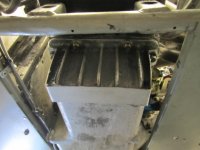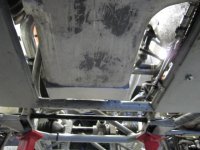Offline
I believe I have arrived at a solution--at least for now--to deal with two persistent oil leaks on the Climax engine of the MK IV.
The leaks were appearing through longitudinal cracks each about 3/8" long just below where the vertical wall of the cast pan turns to form the flange, directly inside of the two studs at the front corners of the sump. The leaks would only appear when the two nuts on the front corners of the pan were snugged up and with the nuts slacked off or removed entirely there was no leaking at all. Perhaps either the flange of the sump or the bottom of the block is not perfectly flat so that a strain is applied to the pan at the turn of the flange when the nuts are tightened, opening the cracks.
Yesterday I made a U-shaped strap out of some thin aluminum stock with ears to pick up the two studs. The length of the vertical legs is about 1/8" less than the depth of the pan and I filled in each radius at the bottom of the strap with epoxy to conform to the shape of the pan. After that set up I coated the inside of the vertical legs with more epoxy and nutted everything up tight, crossed my fingers and went home for the night. This morning I came in and there were no leaks, nor do any appear when the engine has been run and the oil warmed up, etc.
With the two nuts tightened the strap snugs up under the pan and apparently pulls it into shape just enough to relieve the strain on the corners of the pan that was causing the cracks to open enough to allow oil to leak through.
Next time the pan is off I will address the situation properly--either with a sealant such as Glyptol or some welding/stitching but in the meantime I now have a clean garage floor!
Best--Michael Oritt
The leaks were appearing through longitudinal cracks each about 3/8" long just below where the vertical wall of the cast pan turns to form the flange, directly inside of the two studs at the front corners of the sump. The leaks would only appear when the two nuts on the front corners of the pan were snugged up and with the nuts slacked off or removed entirely there was no leaking at all. Perhaps either the flange of the sump or the bottom of the block is not perfectly flat so that a strain is applied to the pan at the turn of the flange when the nuts are tightened, opening the cracks.
Yesterday I made a U-shaped strap out of some thin aluminum stock with ears to pick up the two studs. The length of the vertical legs is about 1/8" less than the depth of the pan and I filled in each radius at the bottom of the strap with epoxy to conform to the shape of the pan. After that set up I coated the inside of the vertical legs with more epoxy and nutted everything up tight, crossed my fingers and went home for the night. This morning I came in and there were no leaks, nor do any appear when the engine has been run and the oil warmed up, etc.
With the two nuts tightened the strap snugs up under the pan and apparently pulls it into shape just enough to relieve the strain on the corners of the pan that was causing the cracks to open enough to allow oil to leak through.
Next time the pan is off I will address the situation properly--either with a sealant such as Glyptol or some welding/stitching but in the meantime I now have a clean garage floor!
Best--Michael Oritt
Attachments
Last edited:

 Hi Guest!
Hi Guest!

 smilie in place of the real @
smilie in place of the real @
 Pretty Please - add it to our Events forum(s) and add to the calendar! >>
Pretty Please - add it to our Events forum(s) and add to the calendar! >> 




